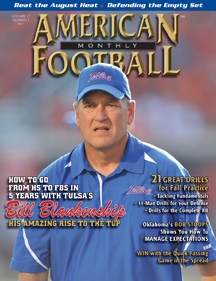AMERICAN FOOTBALL MONTHLY THE #1 RESOURCE FOR FOOTBALL COACHES
Article CategoriesAFM Magazine
|
Drills with a Purpose Practice Systems That Match Your Defensive Objectivesby: Kirk WestreDefensive Coordinator, Whitworth University by: Dave Pomante Defensive Line Coach, Whitworth University © More from this issue Whitworth practices 11-player drills that match the goals of their defense – pursuit, interception, and two-minute drills. Most coaches understand the importance of drilling with a specific purpose in mind. Most educators have stressed the importance of teaching toward a specific objective. However, not all coaches align their drills with their team’s main objectives. We have intentionally aligned our practice drills to match, teach, and reinforce our main defensive objectives. Our defense at Whitworth University is built on four objectives:
Subscribe today!
|
|
|||||||
| HOME |
MAGAZINE |
SUBSCRIBE | ONLINE COLUMNISTS | COACHING VIDEOS |
Copyright 2025, AmericanFootballMonthly.com
All Rights Reserved





